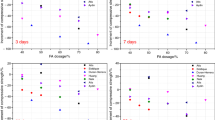Abstract
The calorimetric data of binders containing pure Portland cement, 20% fly ash, 20% slag and 10% silica fume respectively are determined at different initial casting temperatures using an adiabatic calorimeter to measure the adiabatic temperature rising of concrete. The calorimetric data of binders with different dosages of fly ash at two water binder ratios (w/b) are determined, too. Elevation of initial casting temperature decreases the heat evolution of binder, enhances the heat evolution rate of binder and increases the heat evolution rate of binder at early age. The dosage of fly ash in concrete has different effects on the heat evolution of binder with different w/b. At high w/b ratio the heat evolution of binder decreases when dosage of fly ash increases. At low w/b ratio the heat evolution of binders increases when dosage of fly ash increases from 0 to 40% of total binder quantity. The heat evolution of binder decreases after the dosage of fly ash over 40%. An appropriate dosage of fly ash in binder benefits the performance of concrete at low w/b ratio.
Similar content being viewed by others
References
1 R. Springenschmid, Thermal Cracking in Concrete at Early Age, E SPON, 1995.
2 ACI Committee 116 R-85, Cement and concrete terminology, ACI Manual of Concrete Practice, American Concrete Institute Pubs., USA 1989.
W Ma D Sample R Martin PW Brown (1994) Cem. Concr. Aggr. 16 93 Occurrence Handle1:CAS:528:DyaK2MXktVWqtrs%3D Occurrence Handle10.1520/CCA10285J
JG Cabrea CD Atiş (1999) Proceedings of Gramado Conference, Brasil, SP-186 American Concrete Institute Pubs. USA 21
PB Bamforth (1980) Proc. Inst. Civil Eng. 69 777
Z Giergiczny (2005) J. Therm. Anal. Cal. 76 1
MDA Thomas PK Mukherjee JA Sato MF Everitt (1995) Proceedings of Milwaukee Conference, SP-153 American Concrete Institute Pubs. USA 81
B Fournier WS Langley VM Malhotra (1995) Proceedings of Milwaukee Conference, SP-153 American Concrete Institute Pubs. USA 561
PY Yan F Zheng ZQ Xu (2003) J. Therm. Anal. Cal. 74 201 Occurrence Handle1:CAS:528:DC%2BD3sXosVGgtr8%3D Occurrence Handle10.1023/A:1026342222825
ALA Farry JM Bijen YM Haan (1989) Cem. Concr.Res. 19 235 Occurrence Handle10.1016/0008-8846(89)90088-4
H. F. W. Taylor, Cement Chemistry, 2nd Edition, Thomas Telford Services Ltd., 1997.
AK Schindler KJ Folliard (2005) ACI Mater. J. 102 24 Occurrence Handle1:CAS:528:DC%2BD2MXhs1eisLg%3D
Author information
Authors and Affiliations
Corresponding author
Rights and permissions
About this article
Cite this article
Wang, J.C., Yan, P.Y. Influence of initial casting temperature and dosage of fly ash on hydration heat evolution of concrete under adiabatic condition. J Therm Anal Calorim 85, 755–760 (2006). https://doi.org/10.1007/s10973-005-7141-6
Received:
Accepted:
Published:
Issue Date:
DOI: https://doi.org/10.1007/s10973-005-7141-6




